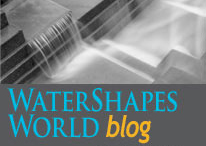ARTICLES
Advance Search
Aquatic Health
Aquatic Health, Fitness & Safety
Around the Internet
Aquatic Culture
Aquatic Technology
Artful Endeavors
Celebrity Corner
Life Aquatic
Must-See Watershapes
People with Cameras
Watershapes in the Headlines
Art/Architectural History
Book & Media Reviews
Commentaries, Interviews & Profiles
Concrete Science
Environment
Fountains
Geotechnical
Join the Dialogue
Landscape, Plants, Hardscape & Decks
Lighter Side
Ripples
Test Your Knowledge
The Aquatic Quiz
Other Waterfeatures (from birdbaths to lakes)
Outdoor Living, Fire Features, Amenities & Lighting
Plants
Ponds, Streams & Waterfalls
Pools & Spas
Professional Watershaping
Structures (Editor's Notes)
Travelogues & History
Water Chemistry
WaterShapes TV
WaterShapes World Blog
Web Links
Around the Internet
Aquatic Culture
Aquatic Technology
Artful Endeavors
Celebrity Corner
Life Aquatic
Must-See Watershapes
People with Cameras
Watershapes in the Headlines
As I prepare to close the book on another year of WaterShapes, I can't resist a bit of basking in the glow - a warm light radiated by an industry to which I've now dedicated more than 30 years of my life. When I started back in 1986, that light was considerably
Through the years, we've worked on lots of projects in remote locations all around the world, from Sri Lanka to Bermuda. In a few instances, we've worked without any site visits - but our strong preference is to see where we're working: It helps move our process along if we get the lay of the land and have the opportunity to meet with clients or architects or property representatives on site. The reasons for this preference are obvious: We draw ideas from what we see, nail down a sense of scale and proportion and head to the drawing board armed with
It's easy to back up an assertion that a good fountain is the key to making a public space work. A monumental statue is great, for instance, but when you add water even in the quiescent form of a reflecting pool, the visitor's experience of the installation is enhanced in many ways. And while big, open plazas may serve as ready-made gathering places, if you add even a small fountain, the overall space will be defined by its presence and visitors will inevitably be drawn to it as a focal point. Public fountains take many forms, but whatever the specifics, their
For years, John Cohen has dedicated himself to meeting the needs of clients averse to using traditional sanitizers. As he reports in the first in a series of articles, his quest began with a narrow-minded 'expert' and has since pulled him toward a biologically inspired set of solutions.
I wouldn't have thought that a bit of Thanksgiving travel could teach me so much about the regional differences among watershapes, but what now seems obvious came as something of a jolt to me. My youngest daughter has a new job in Philadelphia and couldn't get away. Someone suggested we should
‘Not long ago, I was asked by a reporter from The New York Times to define the main difference between swimming pools now compared to what they were 20 years ago. As we talked,’ wrote David Tisherman in his Details column for the December 2007 edition of WaterShapes, ‘it became clear that she was mostly thinking about technological breakthroughs in pumps and chemical treatments and the like. ‘I confirmed for her that, yes, those products had come a long way. But I wouldn’t let her stop there, suggesting that there was much more than
‘Believe it or not,’ wrote Brian Van Bower in his Aqua Culture column for November/December 2002, ‘goals can guide almost everything we do, from how we schedule our time to how we establish our business and personal relationships or determine the things we
I had traveled through Italy before, but I'd never been to Venice - and arrived there late in June 2017 with all sorts of expectations and suppositions about what I'd find, especially when it came to water. The city is a collection of islands in a marshy
For more than 50 years, our company has focused on designing and building swimming pools for municipalities, universities, health clubs, state parks, swim clubs, subdivisions, apartments and hospitals - with some residential projects added in for good measure. We're good at what we do, and if we've learned anything through the years, it's that we're successful because we approach each and every project as being
I'm freshly returned from the International Pool|Spa|Patio Expo, loaded with memories and impressions and ready to set my course for the year to come. I had the editorial conversations I needed to have, conferred with old friends and new acquaintances and met with multiple suppliers to




















